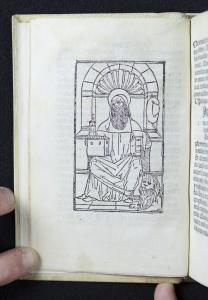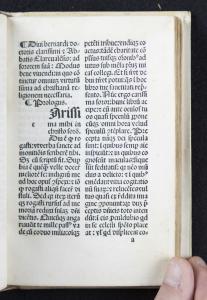

The works in this exhibit are all later versions or publications of titles, authors, or documents that are represented in the Rouse Medieval Manuscript collection. The exhibit content was created by students in a History of the Book seminar in Winter 2014 in the Information Studies Department at UCLA.
Exhibit Home
1. An exact collection of all remonstrances,...
3. Divi Avrelii Avgvstini Hippon. Episcopi...
4. Horae in laudem beatiss[ima] Virginis secu[n]dum....
5. Hore in laudem beatissime Virg[inis] Marie...
6. Les memoires, contenans le discours de plusieurs...
7. Modus Bene Viuendi (Modus Bene Vivendi)
8. Psalteriu[m] v[ir]ginis sanctissime [secundum]...
9. Q. Asco. Pediani In Ciceronis orationes...
10. Quaestiones super XII libros Metaphysicae...
11. Stimulus diuini amoris Sancti Bonauenturae
12. Varii sermoni de Santo Agostino...
13. Varii sermoni di Santo Agostino
Title Modus Bene Viuendi (Modus Bene Vivendi)


Brief description
Bernard of Clairvaux was a French abbot and a prominent leader in the establishment of the reformed Cistercian order. During his lifetime he wielded considerable power in the Church, establishing numerous monasteries throughout Europe, and becoming the first Cistercian monk placed on the calendar of saints (August 20).
Written in the mid-eleventh century, Modus Bene Vivendi, or A Rule of Good Life provides pious spiritual instruction to young women coming of age, as well as general mystical teaching. This edition, printed in gothic script on paper bound in vellum, was produced in 1494 and highlights his lasting influence as a teacher of Christian mysticism. He continues to be among the most important Catholic saints, still read to this day by everyone from popes to students.
Physical description
The cover is animal skin, likely calfskin, with title, author, and date printed on spine, likely at later date. Appears to be threaded binding. Paper pages, 2 columns of 27 lines. Gothic script. Areas for initials were left blank. The remnants of a Romanesque binding are evident, with unused slits for lacing remaining on the upper and lower board. The woodcut illustration on the 3rd page features a bearded man holding a church model in his right hand, a book in his left, and a lion at his feet, who likely represents Pope Alexander VI, the pope during the time of printing (1492-1503). Of a venerable age, this book has been well cared for, and has traveled through at least two libraries in Great Britain.
Content descriptionModus Bene Vivendi, roughly translated as “A mode of living well” or “A rule of good life,” was written by Saint Bernard of Clairvaux. There are many different editions representing this title, but the earliest appears to be published in 1492 in Venice.
The work is addressed in second person to a woman whom Bernard calls “sister,” likely meaning sister in Christ. This establishes the text as spiritual instruction for women, and reads as a pious exhortation from men to women. The text was likely read in religious settings, in church or in a well-to-do religious home, and used as a tool for prayer and meditation for young women.
Saint Bernard may be best known for his “Sermones super Cantica Conticorum” or "Sermons on the Song of Songs,” which include textual versions of his sermons from 1135 until his death in 1153. He authored many religious texts such as “De Conversione ad Clericos Sermo Seu Liber” (On the Conversion of Clerics), De diligendo Dei (On Loving God), and De Laude Novae Militae (In Praise of the New Knighthood), written in service of the Knights Templar.
Bernard of Clairvaux was born to noble parents in Burgundy, France, in the castle of Fontaines near Dijon in 1090 or 1091. At an early age he was sent to college at Chatillon, where he studied theology and scripture. Following the death of his mother, he entered the newly established Cistercian order, of which he would later become the greatest reformer and spokesperson. With several other monks, he founded the Abbey of Clairvaux where he served as Abbot and began an active life of religious writing. He also traveled frequently and contributed to the founding of monasteries throughout Europe.
He defended the Church against the encroachments of kings and princes. He was secretary at the Council of Troyes, convened to settle certain disputes of the bishops of France and other church issues. His service made a great impression on the cardinal, and it was here that he traced the outlines of the Rule of the Knights Templar. He was instrumental in drumming up enthusiasm for the Crusades throughout Europe. Because of his great piety and prolific mystical writings, he was offered the position of bishop several times, but he always refused, preferring instead a humble monastic life. Since the period of his lifetime, numerous popes have been influenced by his writings. He died on August 20, 1153.
Contributor: Sean Gates
Contribution date: Winter 2014
Full title: Modus Bene Viuendi (Modus Bene Vivendi)
Date May 30, 1494
Location Venice (Venetiae)
Dimensions 16 cm x 10 cm x 2cm
Additional information UCLA holds 4 copies of early printings of this work. They date 1494, 1495, 1502, and 1633. The 1633 copy is a scanned, online resource in English (trans. R. Father Antonie Batt).
UCLA also holds an Italian translation of the work. A search of WorldCat shows 16 physical copies available throughout North America and Europe, with 7 available via microfilm. University of Michigan hosts a free hypertext version of the English translation by Thomas Paynell.
WorldCat shows 31 different editions of the book in various European languages, ranging in publication date from 1492 to 1830. Most likely this document is related to the Rouse manuscript entitled “Monastic Miscellany or Bernard of Clairvaux and Others: Florence, Italy 1484,” as the author and time period match perfectly.
This text will interest scholars of medieval history, Christianity, History of the Book, and women’s studies. The book illustrates the religious life of women during the 12th century, and so offers a unique sociological perspective to today’s researcher. As a saint of the Catholic Church, and among the greatest writers of Christian mystical theology, Bernard’s works continue to be relevant to Catholics today.
Condition Pages show browning and yellowing, centered around the text. Multiple pages show water stains at the edge. A small, circular snip off the edge of the last six pages is missing, measuring about 1 square millimeter, perhaps the result of mice. The front cover still contains two bookplates of previous owners.